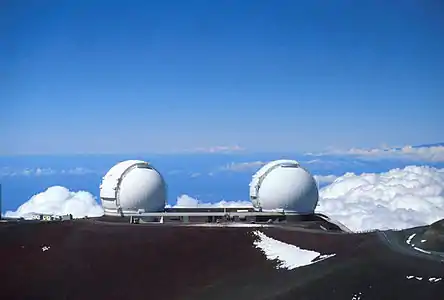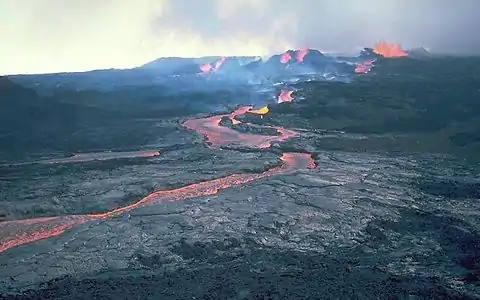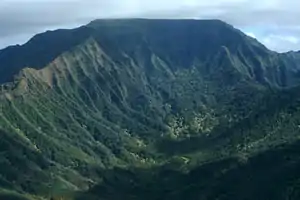List of mountain peaks of Hawaii
This article comprises three sortable tables of the 13 major mountain peaks[lower-alpha 1] of the Hawaiian Islands and the U.S. State of Hawaiʻi. Each of these 13 major summits has at least 500 meters (1640 feet) of topographic prominence.

The summit of a mountain or hill may be measured in three principal ways:
- The topographic elevation of a summit measures the height of the summit above a geodetic sea level.[1] The first table below ranks the 13 major summits of Hawaiʻi by topographic elevation.
- The topographic prominence of a summit is a measure of how high the summit rises above its surroundings.[2][1] The second table below ranks the 13 major summits of Hawaiʻi by topographic prominence.
- The topographic isolation (or radius of dominance) of a summit measures how far the summit lies from its nearest point of equal elevation.[3] The third table below ranks the 13 major summits of Hawaiʻi by topographic isolation.
Highest major summits
Of the 13 major summits of Hawaiʻi, Mauna Kea and Mauna Loa exceed 4000 meters (13,123 feet) elevation, Haleakalā exceeds 3000 meters (9843 feet), Hualalai exceeds 2000 meters (6562 feet), and 11 peaks exceed 1000 meters (3281 feet) elevation.
Four of these peaks rise on the island of Hawaiʻi, two on Maui, two on Kauaʻi, two on Molokaʻi, two on Oʻahu, and one on Lānaʻi.
Most prominent summits
Of the 13 major summits of Hawaiʻi, Mauna Kea exceeds 4000 meters (13,123 feet) of topographic prominence, Haleakalā exceeds 3000 meters (9843 feet), Mauna Loa exceeds 2000 meters (6562 feet), six peaks are ultra-prominent summits with more than 1500 meters (4921 feet), and eight peaks exceed 1000 meters (3281 feet) of topographic prominence.
Most isolated major summits
Of the 13 major summits of Hawaiʻi, Mauna Kea has 3947 kilometers (2453 miles) of topographic isolation and four peaks exceed 100 kilometers (62.14 miles) of topographic isolation.
Gallery
 Mauna Kea on the Island of Hawaiʻi is the tallest mountain on Earth as measured from base to summit.
Mauna Kea on the Island of Hawaiʻi is the tallest mountain on Earth as measured from base to summit. Mauna Loa on the Island of Hawaiʻi is the second most voluminous mountain on Earth.
Mauna Loa on the Island of Hawaiʻi is the second most voluminous mountain on Earth. Haleakalā is the highest summit of the Island of Maui.
Haleakalā is the highest summit of the Island of Maui. Kaʻala is the highest summit of the Island of Oahu.
Kaʻala is the highest summit of the Island of Oahu.
See also
- List of mountain peaks of the United States
- List of mountain peaks of Alaska
- List of mountain peaks of Arizona
- List of mountain peaks of California
- List of mountain peaks of Colorado
- List of mountain peaks of Hawaii
- List of mountains of Hawaii
- List of the ultra-prominent summits of Hawaii
- List of mountain peaks of Idaho
- List of mountain peaks of Montana
- List of mountain peaks of Nevada
- List of mountain peaks of New Mexico
- List of mountain peaks of Oregon
- List of mountain peaks of Utah
- List of mountain peaks of Washington (state)
- List of mountain peaks of Wyoming
- Hawaii
- Geography of Hawaii
- Geology of Hawaii
- Category:Mountains of Hawaii
- Physical geography
References
- If the elevation or prominence of a summit is calculated as a range of values, the arithmetic mean is shown.
- The topographic prominence of a summit is the topographic elevation difference between the summit and its highest or key col to a higher summit. The summit may be near its key col or quite far away. The key col for Denali in Alaska is the Isthmus of Rivas in Nicaragua, 7642 kilometers (4749 miles) away.
- The topographic isolation of a summit is the great-circle distance to its nearest point of equal elevation.
- "SUMMIT". Datasheet for NGS Station TU2314. U.S. National Geodetic Survey. Retrieved 18 May 2016.
- "Mauna Kea". Geographic Names Information System. United States Geological Survey.
- "Mauna Kea". Peakbagger.com. Retrieved 18 May 2016.
- "Mauna Kea". Bivouac.com. Retrieved 18 May 2016.
- "Mauna Loa". Geographic Names Information System. United States Geological Survey.
- "Mauna Loa". Peakbagger.com. Retrieved 18 May 2016.
- "Mauna Loa". Bivouac.com. Retrieved 18 May 2016.
- "Haleakalā". Geographic Names Information System. United States Geological Survey.
- "Haleakalā". Peakbagger.com. Retrieved 18 May 2016.
- "Haleakalā". Bivouac.com. Retrieved 18 May 2016.
- "Hualālai". Geographic Names Information System. United States Geological Survey.
- "Hualālai". Peakbagger.com. Retrieved 18 May 2016.
- "Hualālai". Bivouac.com. Retrieved 18 May 2016.
- "Puʻu Kukui". Geographic Names Information System. United States Geological Survey.
- "Puʻu Kukui". Peakbagger.com. Retrieved 18 May 2016.
- "Puʻu Kukui". Bivouac.com. Retrieved 18 May 2016.
- "Kaunu o Kaleihoohie". Geographic Names Information System. United States Geological Survey.
- "Kaunu o Kaleihoohie". Peakbagger.com. Retrieved 18 May 2016.
- "Kaunu o Kaleihoohie". Bivouac.com. Retrieved 18 May 2016.
- "Kawaikini". Geographic Names Information System. United States Geological Survey.
- "Kawaikini". Peakbagger.com. Retrieved 18 May 2016.
- "Kawaikini". Bivouac.com. Retrieved 18 May 2016.
- "Kamakou". Geographic Names Information System. United States Geological Survey.
- "Kamakou". Peakbagger.com. Retrieved 18 May 2016.
- "Kamakou". Bivouac.com. Retrieved 18 May 2016.
- "Olokuʻi". Geographic Names Information System. United States Geological Survey.
- "Olokuʻi". Peakbagger.com. Retrieved 18 May 2016.
- "Kaʻala". Geographic Names Information System. United States Geological Survey.
- "Kaʻala". Peakbagger.com. Retrieved 18 May 2016.
- "Kaʻala". Bivouac.com. Retrieved 18 May 2016.
- "Lānaʻihale". Geographic Names Information System. United States Geological Survey.
- "Lānaʻihale". Peakbagger.com. Retrieved 18 May 2016.
- "Lānaʻihale". Bivouac.com. Retrieved 18 May 2016.
- "Kōnāhuanui". Geographic Names Information System. United States Geological Survey.
- "Kōnāhuanui". Peakbagger.com. Retrieved 18 May 2016.
- "Kōnāhuanui". Bivouac.com. Retrieved 18 May 2016.
- "Hāʻupu". Geographic Names Information System. United States Geological Survey.
- "Hāʻupu". Peakbagger.com. Retrieved 18 May 2016.
Notes
- This article defines a significant summit as a summit with at least 100 meters (328.1 feet) of topographic prominence, and a major summit as a summit with at least 500 meters (1640 feet) of topographic prominence. An ultra-prominent summit is a summit with at least 1500 meters (4921 feet) of topographic prominence.
- The summit of Mauna Kea is the highest point of the island of Hawaiʻi, the U.S. State of Hawaiʻi, and all islands of the Pacific Ocean.
- Mauna Kea is the tallest mountain on Earth as measured from base to summit. The shield volcano sits on the ocean floor at a depth of 5998 meters (19,678 feet) for a total height of 10,205.3 meters (33,482 feet).
- Mauna Loa is the southernmost and westernmost 4000-meter (13,123-foot) summit of Hawaiʻi and the United States.
- The shield volcano Mauna Loa is the second most voluminous mountain on Earth with an estimated volume of 74,000 cubic kilometres (18,000 cu mi), or enough material to fill the Grand Canyon more than 18 times
- The summit of Haleakalā is the highest point of the island of Maui and the westernmost 3000 meter (9842.5-foot) summit of the United States.
- The summit of Kawaikini is the highest point of the island of Kauaʻi.
- The summit of Kamakou is the highest point of the island of Molokaʻi.
- The summit of Kaʻala is the highest point of the island of Oʻahu.
- The summit of Lānaʻihale is the highest point of the island of Lānaʻi.

